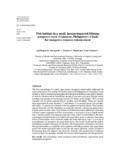| dc.contributor.author | Primavera, Jurgenne | |
| dc.contributor.editor | Quinitio, Emilia T. | |
| dc.contributor.editor | Parado-Estepa, Fe Dolores | |
| dc.contributor.editor | Coloso, Relicardo M. | |
| dc.date.accessioned | 2017-08-25T08:48:17Z | |
| dc.date.accessioned | 2017-08-25T16:36:35Z | |
| dc.date.available | 2017-08-25T08:48:17Z | |
| dc.date.available | 2017-08-25T16:36:35Z | |
| dc.date.issued | 2017 | |
| dc.identifier.citation | Primavera, J. H. (2017). Mangroves as mud crab habitats. In E. T. Quinitio, F. D. Parado-Estepa, & R. M. Coloso (Eds.), Philippines : In the forefront of the mud crab industry development : proceedings of the 1st National Mud Crab Congress, 16-18 November 2015, Iloilo City, Philippines (pp. 99-103). Tigbauan, Iloilo, Philippines: Aquaculture Department, Southeast Asian Fisheries Development Center. | en |
| dc.identifier.isbn | 9789719931072 | |
| dc.identifier.uri | http://hdl.handle.net/10862/3162 | |
| dc.description.abstract | The paper reports the use of mangroves by Scylla species both as wild and culture habitats. Based on published literature, natural mangrove crab populations are described in terms of population density, dispersal and movement within and outside mangroves, crab burrows and associated mangrove species. Strategies for Scylla conservation depend on the kind of mangrove habitat - (mangrove) restoration for open fringing mangroves where crab recruitment and abundance are determined by habitat availability vs stock enhancement in closed basin mangroves with restricted recruitment and limited movement of crabs.
Mangrove crabs are also reared in monoculture in mangrove cages and pens, or in polyculture with milkfish in extensive ponds (where mangroves used to thrive). The paper describes a SEAFDEC Aquaculture Department study to evaluate the effects of mud crab net pen systems on mangrove macroflora, and the replacement of dietary trash fish with low-cost pellets. Results showed that incomplete, low-cost pellets can replace fish biomass requirement in mud crab diets, but that crab presence resulted in fewer mangrove seedlings and saplings. Economic analysis showed the viability of crab culture in mangrove pens using a combination of fish biomass and pellets to reduce the requirement for (low-value) fish, which is a food item of poor coastal communities. | en |
| dc.language.iso | en | en |
| dc.publisher | Aquaculture Department, Southeast Asian Fisheries Development Center | en |
| dc.subject | Scylla | |
| dc.subject | Philippines | en |
| dc.subject | monoculture | en |
| dc.title | Mangroves as mud crab habitats | en |
| dc.type | Conference paper | en |
| dc.citation.spage | 99 | |
| dc.citation.epage | 103 | |
| dc.subject.asfa | aquaculture economics | en |
| dc.subject.asfa | aquaculture techniques | en |
| dc.subject.asfa | associated species | en |
| dc.subject.asfa | cage culture | en |
| dc.subject.asfa | crab culture | en |
| dc.subject.asfa | culture effects | en |
| dc.subject.asfa | feeds | en |
| dc.subject.asfa | feeding | en |
| dc.subject.asfa | habitat improvement (biological) | en |
| dc.subject.asfa | Habitat | en |
| dc.subject.asfa | mangrove swamps | en |
| dc.subject.asfa | mangroves | en |
| dc.subject.asfa | marine crustaceans | en |
| dc.subject.asfa | polyculture (aquaculture) | en |
| dc.subject.asfa | population density | en |
| dc.subject.asfa | population dynamics | en |
| dc.subject.asfa | resource conservation | en |
| dc.subject.asfa | seedlings | en |
| dc.subject.asfa | stocking (organisms) | en |
| dc.subject.asfa | stocks | en |
| dc.citation.conferenceTitle | Philippines : In the forefront of the mud crab industry development : proceedings of the 1st National Mud Crab Congress, 16-18 November 2015, Iloilo City, Philippines | en |



